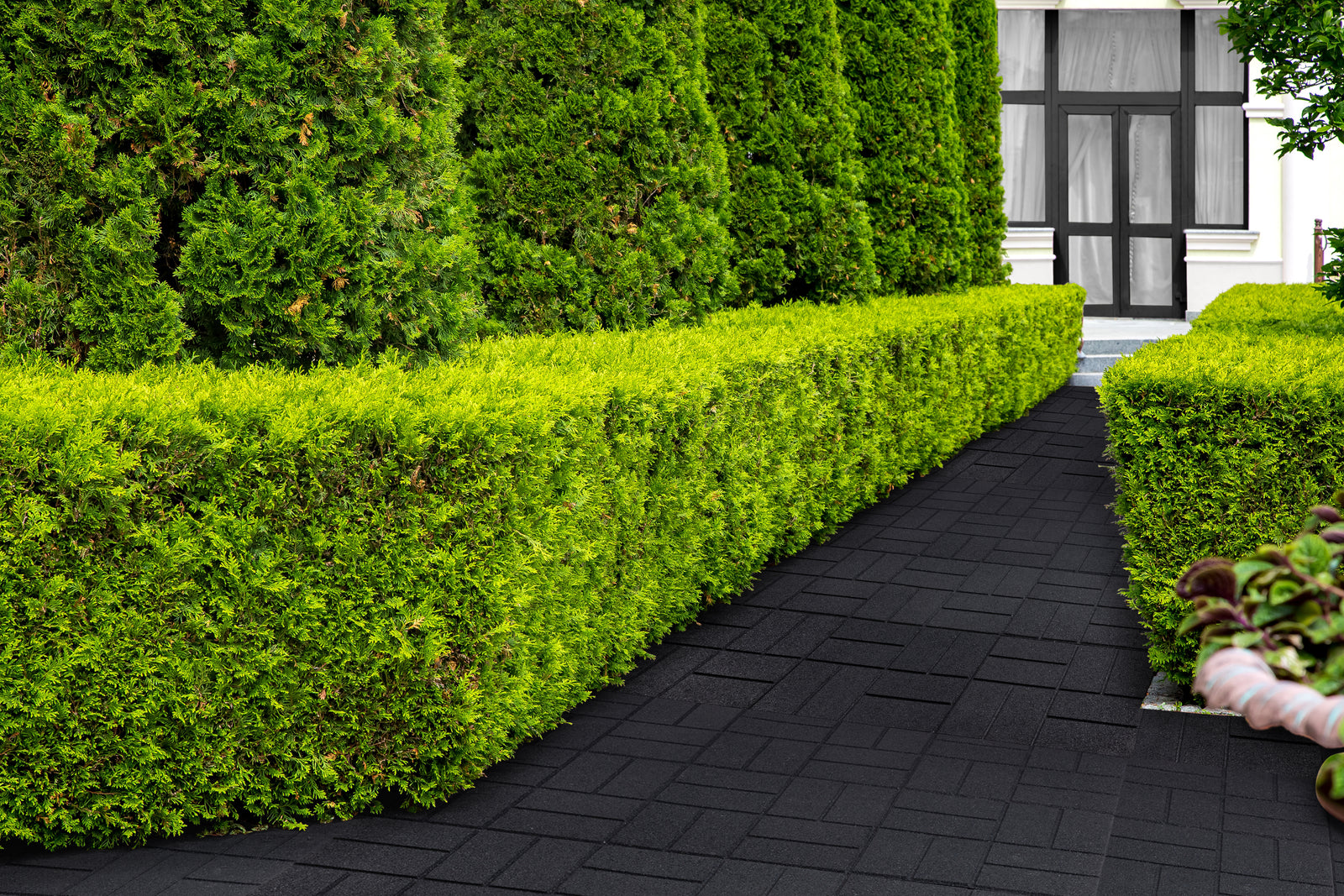October 28, 2024
Create Your Own Sensory Path with Rubber Pavers
Sensory Paths and Rubber Pavers are Perfect Together
When you’re ready to add an engaging element to your outdoor space, consider creating a fun sensory path. More than just a walkway, this pathway stimulates its user's cognitive functions. For example, it provides children with sensory input by adding activities and movements that encourage motor skills and sensory development.
Rubber pavers, known for creating amazing garden pathways, are some of the best materials on the market for creating an outdoor sensory path that provides sensory stimulation, visual interest, and guided movement.
What is a sensory path?
Sensory pathways combine sensory stimulation, encourage physical movement, and provide learning elements to support a child’s development and well-being. By guiding children through a series of movements and activities, parts of the brain and body are engaged.
How does a sensory path engage children?
There are lots of ways to wake up your child’s senses with sensory paths that provide stimuli to:
- Encourage movement: Provide patterns and create shapes that encourage physical activity and movement like jumping, hopping, spinning, and balancing.
- Stimulate various senses: Use textures and colors to engage multiple senses including vision, touch, vibration, balance, and proprioception.
- Engage the brain: Add learning elements to engage the brain with letters, shapes, or numbers.
What are the benefits of creating a sensory pathway?
Sensory walkways benefit children in several ways including:
- Physical activity and movement are promoted through strategic placement of visual cues that can include colors, patterns, textures, paint, chalk, tape, and other elements on floors, paths, walls, playgrounds, and other outdoor play areas.
- Motor skills are developed through hand-eye coordination, balance, and spatial awareness.
- Sensory processing needs and spatial awareness are supported by helping children integrate sensory inputs for their sensory development and the ability to process information.
- Balance and coordination are improved along with other basic locomotor movement skills.
- Improves attention and focus while also providing a break for the brain when transitioning from daily routine activities or when a movement break is needed.
- Aids with self-regulation when energy levels need to be increased or decreased, and helps with managing sensory overload.
Can a sensory pathway be customized?
Yes, you can customize a sensory pathway to accommodate various areas and fit the needs of an age group or developmental need. These paths can be used for different purposes to support a child’s development in various environments including outdoor spaces, therapeutic, and educational.
What kind of elements can be used for a sensory path?
Several elements can be incorporated into a typical sensory path including footprints, decals, learning elements (letters/numbers), circular patterns, hopscotch-type patterns, twisting lines, zigzag arrows or lines, movement prompts like “jump” or “spin.”
Can I create a sensory path with interlocking rubber pavers?
Yes, the good news is that you can create your sensory path outdoors by incorporating rubber pavers using different colors and patterns to stimulate the senses. Rubber pavers are an ideal material to use when creating a sensory path.
In addition to being exceptionally durable, the highest quality rubber pavers are slip-resistant and shock-absorbent. This is why you’ll find this material widely used in playgrounds, schools, and other areas where children walk, run, hop, or play.
What are the best design ideas for sensory pathways using pavers?
- Create a flow of movement throughout the path to encourage continuous progress.
- Consider different colors to add borders and differentiate between zones and activities.
- Use and combine textured and smooth pavers to provide a variety of textures.
- Try adding an overall theme like using starfish for an ocean theme, stars for a space theme, etc.
- Use basic learning elements such as letters, shapes, and numbers.
- Customize the path to suit the needs of your child’s age and abilities with various movements and activities (hop, jump, spin, color recognition, etc.).
Do interlocking rubber pavers come in different colors?
Choose from red, dark grey, brown, or black to stimulate the senses and create visual appeal. For example, dark grey and/or black pavers are perfect to provide visual boundaries or to add contrast.
Can I incorporate different patterns with pavers?
Interlocking pavers come in different patterns and can also be cut and/or laid in different configurations to create patterns. When used on a sensory path, these tiles can engage children through visual interest and guiding movement. Here are some ideas to consider:
- Encourage exercising like running or walking with straight lines or tracks.
- Promote twirling, turning, or spinning with round or circular patterns.
- Help encourage coordination and balance with zigzag lines.
- Foster counting, hopping, and jumping with hopscotch-type layouts.
- Guide movement with various obstacles, footprints, handprints, and other shapes.
- Encourage cognitive abilities using elements like letters and numbers.
How do I create a sensory path with rubber pavers?
Making your own sensory path is a rewarding and fun DIY project that will benefit your child’s development skills while enhancing your outdoor area. Here are some basic steps to follow:
- Decide where you want to create your pathway relative to space and environment (e.g., outdoor garden area).
- Take proper measurements and order enough pavers in various colors according to your design and add additional tiles for cut-outs, etc.
- Prepare the various elements (paver cut-outs like footprints, numbers, letters, shapes etc.) you want to incorporate.
- Clear the area of debris and prep and level the ground surface before installing the pavers.
- Install the interlocking pavers according to your design and by following manufacturer/supplier recommendations.
- Clean the area before applying any additional decals or stickers, tape, or other elements.
- Enjoy watching your child excel!
What are the benefits of using rubber pavers for my sensory path?
The advantages of using rubber pavers to create a fun and engaging sensory path for kids are many. Take a look at these benefits:
- Safer – Rubber pavers are slip-resistant, especially in wet conditions from sprinklers or weather. They are also shock- absorbing and therefore provide a safer surface for children. The risk of injuries from falls is reduced due to its cushiony nature. This makes them ideal for the sensory experience and is why they are so popular in areas where children play, skip, jump, or walk.
- Easy to install – Compared to concrete, stones, or bricks, pavers are simple to install and can be replaced or rearranged.
- Fosters creativity – Create fun shapes and patterns to enhance your sensory path by cutting out shapes using a utility knife, jigsaw, or other household tools.
- Easy to maintain – As an outdoor material, rubber pavers are low maintenance and repel bugs, mold, and fungi. Just sweep and hose the areas when needed.
- Durability – Able to resist bad weather conditions, chipping, cracking, and other outdoor elements, rubber pavers are also tough on heavy foot traffic. With proper installation and maintenance, pavers have a lifespan of up to 20 years.
- Eco-friendly – Rubber pavers are composed from recycled rubber tires found in landfills.
Installing interlocking rubber pavers are a great choice when you’re thinking of creating the ultimate outdoor sensory pathway. There are plenty of options and ways to capture your child’s interest while developing important motor skills with pavers.

Also in Rubber Mulch Blog

Embracing Eco-Friendliness by Choosing Rubber Mulch for Your Playground
June 17, 2025
“Reuse, Recycle, and Reduce” are three main aims when it comes to preserving the health of our planet. Rubber mulch definitely falls within their scope. Conserving resources, energy efficiency, and better health for kids are all rubber mulch benefits.

Effective Mold and Fungi Prevention: The Hidden Value of Rubber Mulch
October 31, 2024

Install Rubber Pavers for a Garden Pathway Makeover!
October 15, 2024
shop
Copyright © 2026 RubberMulch.com - All Rights Reserved.






